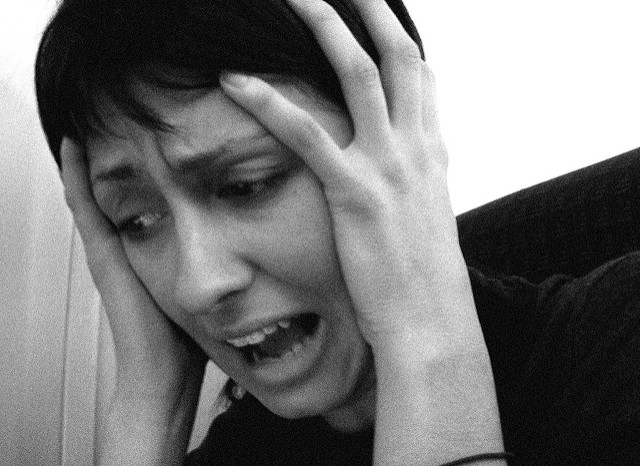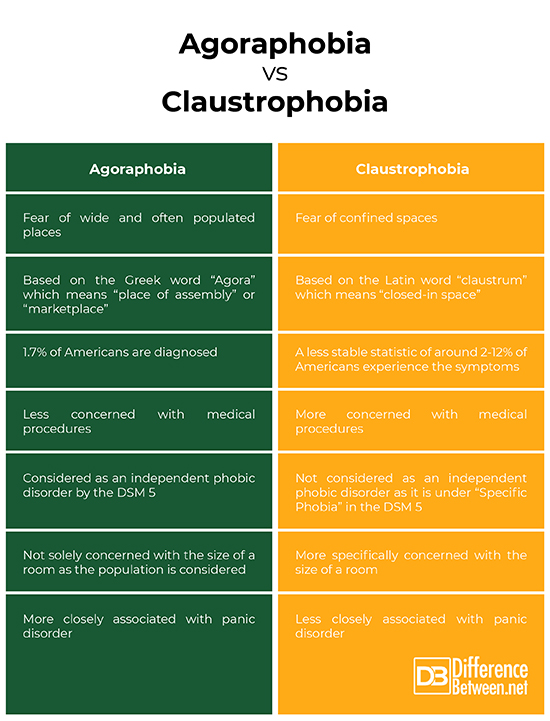Difference Between Agoraphobia and Claustrophobia
Both agoraphobia and claustrophobia are characterized by irrational and persistent distress as “phobos” is a Greek word which means “fear”.
They also involve spatial issues and have overlapping symptoms. The cause is often a combination of conditioning and evolutionary factors and are usually treated through psychotherapy and medication.

Being under anxiety disorders in the Diagnostic and Statistical Manual of Mental Disorders (DSM 5), these mental health issues involve vigilance, muscular tension, and other fight, flight, or freeze behaviors.
The general symptoms for phobia are:
- Irrational fear which has been persistent for at least 6 months
- Excessive fear which significantly disrupts routine and relationships
- Escape and avoidance behaviors in response to the source of fear
- Anxiety responses such as panic attacks, clinging, or crying
- Thinking of the source of fear leads to sweating, chills, rapid heartbeat, dizziness, choking, chest pain, and/or disorientation
Regarding their distinction, agoraphobia is a fear of open spaces while claustrophobia is a fear of enclosed spaces.
Hence, many agoraphobics prefer to be in the safety of their rooms while claustrophobics prefer to be in wide and open areas. The following discussions further delve into their differences.
What is Agoraphobia?
Agoraphobia is based on the Greek word “agora” which means “place of assembly” or “marketplace”. Affected individuals often think that they can turn to no one for help when panic attacks would likely occur or they feel that being in a crowded place would be very embarrassing since they would probably manifest anxiety symptoms.
Thus, the number of people in the room is a big factor in escalating the fear. Agoraphobia is one of the common phobias that is why it is specified in the DSM 5. The diagnostic criteria specify a marked fear of at least two of the following:
- Using public transportations like ships and buses
- Being in open spaces like public markets and parking lots
- Being in enclosed areas like cinemas or theaters
- Being in a crowd or a long queue
- Being out of the house alone
What is Claustrophobia?
Claustrophobia came from the Latin word “claustrum” for “a closed-in place” is the irrational fear of confined spaces.
Actually, what triggers the fear is the thought of what could happen in a certain enclosed area.

For instance, an individual may feel trapped and may often think that he would eventually gasp for air when in a small room. Some of the usual places that evoke such fear are:
- Elevators
- MRI scanners
- Vehicles such as cars, trains, and planes
- Revolving doors
- Tunnels or caves
- Small bathrooms
- Cellars
Differences between Agoraphobia and Claustrophobia
-
Source of Fear in Agoraphobia Vs. Claustrophobia
People with agoraphobia fear wide and often populated places such as amusement parks and airports. On the other hand, individuals with claustrophobia fear confined spaces which often restricts movements like MRI scanners, public toilets, and elevators.
-
Etymology
“Agora” is a Greek word which translates to “place of assembly” or “marketplace” while “claustrum” is a Latin word which means “closed-in space”.
-
Prevalence
The DSM 5 states that around 1.7 % of adolescents and adults in America are diagnosed with agoraphobia every year. However, claustrophobia has a less solid statistic regarding affected individuals; sources claim that around 2-12% Americans manifest the symptoms.
-
Fear of Medical Procedures
As compared to agoraphobia, claustrophobia is more closely related with medical procedures as claustrophobics fear MRI scanners and hyperbaric oxygen chambers. Some may also feel marked anxiety when undergoing x-ray procedures
-
DSM 5
Agoraphobia is more psychiatrically recognized as an independent disorder as it is specified in the DSM 5. It is with the ICD-9-CM code of 300.2 and the ICD-10-CM code of F40.00. On the contrary, claustrophobia is considered to be under “Specific Phobia” which is defined as having “marked fear or anxiety about a specific object or situation”. The ICD-9-CM code is 300.29 which covers situational sources of fear with the ICD-10-CM code of F40.248.
-
Size of a Room
As compared to agoraphobia, claustrophobia is more concerned with the size of a room as they are particularly uncomfortable with narrow spaces. As for agoraphobics, they factor in the population as they are not comfortable with crowds. Hence, being in a wide room with 2 people would be generally fine but being in the same room with 50 people would be dreadful.
-
Panic Disorder
As compared to claustrophobia, agoraphobia is more closely linked with panic disorder as the anticipatory anxiety of having to be with a number of people leads to having panic attacks. In fact, panic disorder is included in the list of comorbidities under agoraphobia in the DSM 5. As for specific phobia, which claustrophobia is under, panic disorder was not specified under its comorbidities. Instead, depression was highlighted as frequently associated with it.
Agoraphobia vs Claustrophobia

Summary of Agoraphobia Vs. Claustrophobia
- Both agoraphobia and claustrophobia are characterized by irrational and persistent distress as “phobos” is a Greek word which means “fear”.
- The cause for the phobias is often a combination of conditioning and evolutionary factors and are usually treated through psychotherapy and medication.
- Agoraphobia is a fear of open spaces while claustrophobia is a fear of enclosed spaces.
- As compared to agoraphobia, claustrophobia is more concerned with medical issues.
- Agoraphobia is considered as an independent phobic disorder in the DSM 5 while claustrophobia is not.
- Difference Between Hematoma and Melanoma - February 9, 2023
- Difference Between Bruising and Necrosis - February 8, 2023
- Difference Between Brain Hematoma and Brain Hemorrhage - February 8, 2023
Search DifferenceBetween.net :
Leave a Response
References :
[0]American Psychiatric Association. Diagnostic and Statistical Manual of Mental Disorders, 5th Ed. Washington, DC: American Psychiatric Publishing, 2013. Print.
[1]Mathew, Hal. Un-agoraphobic. San Francisco, CA: Weiser Books, 2014. Print.
[2]Perry, Andrea. Claustrophobia. New York, NY: Worth Publishing, 2007. Print.
[3]Image credit: https://www.flickr.com/photos/nate/321938695
[4]Image credit: https://www.flickr.com/photos/lauralewis23/7515253900
